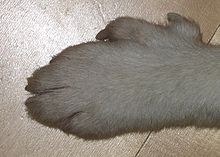Norwegian Lundehund
| Norwegian Lundehund | ||
|---|---|---|
|
|
||
| FCI Standard No. 265 | ||
|
||
| Origin : | ||
| Alternative names: |
Norsk Lundehund |
|
| Withers height: |
Male 35-38 cm. |
|
| Weight: |
Male ≈7 kg, |
|
| List of domestic dogs | ||
The Norwegian Lundehund is an FCI recognized Norwegian breed of dog ( FCI Group 5, Section 2, Standard No. 265 ). The breed was bred and used to hunt puffins ( Norwegian Lunde ).
Origin and history
In 1591 the dogs were mentioned in a chapter on the island of Værøy by Erik Hansen Schønnebøl . The Italian Francesco Negri reported in 1666 about similar dogs in Finnmark .
All lundehounds living today have their ancestors in Måstad on Værøy, as they were almost extinct. The residents of Røst , who had also hunted birds with their dogs for centuries, switched to catching birds with a net. This more effective method was also adopted on Værøy in some areas, so that the dogs became superfluous. They started roaming around and poaching. The local authorities on Røst and Værøy therefore decided to introduce a dog tax, which meant that there were hardly any dogs left on the islands in a short time.
In Måstad they still needed the Lundehund and after some protests they got a tax reduction. This made Måstad the only place where this breed still existed and because of its remoteness it did not mix with other dogs. Eleonora Christi heard about this situation in 1938. Realizing that this breed was on the verge of extinction, she got herself three bitches and one male to save the population. Three years later they had to resort to their breeding, because in Måstad all dogs died of distemper in a short time . Eleonora Christi then gave the residents four dogs, with which a new breed was established.
Today there is a small but secure stock. In 2005 there were 1015 Lundehounds registered with the National Breeding Association of Norway, NKK.
description
Up to 38 cm tall and around 7 kg heavy special hunting dog.
The fur is usually red to pale brown with white and has black hair tips in places. It is strong, close-fitting and relatively short with a soft undercoat . White dogs with dark markings also meet the breed standard . The young dog usually has even fewer black tips in the top coat than adult dogs.
The Lundehund has triangular ears of medium size, broad at the base, carried upright and a half-length, densely hairy tail, ring-shaped or slightly rolled over the back or carried hanging down.
Specialty
Lundehounds have been used to hunt puffins on some islands in Lofoten . For this purpose, special anatomical features were bred for them. A special shoulder girdle enables the animal to stretch both forelegs to the side at a 90 ° angle. The head can be bent backwards up to the spine, which means that the dog can make itself “shorter”. In order not to injure the puffin too much, the dogs have up to eight fewer molars. Furthermore, a Lundehund is able to fold the normally pointed upward ears through a transverse fold in the ear cartilage in order to protect its ear canals from dirt and dripping water. In the breed standard, the paws are described as follows:
- Front feet: Oval, slightly outwardly turned paws with at least six toes, five of which are effective, i.e. to support the dog. Eight pads on each paw. Anatomically, the thumb complex consists of a fused three-part toe and a two-part toe with the associated tendons and muscles.
- Hind feet: Oval, slightly outwardly turned paws with at least six toes, four of which are effective, i.e. to support the dog. Seven pads on each paw. The middle pad, the largest, has grown together with the two inner pads. When the dog is standing normally on a level surface, the weight of the body is normally distributed across the balls of the toes.
health
→ Main article: Lundehund Syndrome
Essence
The Norwegian Lundehund is very vigilant, energetic and lively, fond of children and very friendly. He usually gets along well with other dogs. But he is also sensitive and shy.
Sources and further links
Individual evidence
- ↑ Dag Sørli: The old fowlers' village. Måstad on Værøy (= Fotefar mot nord. Vol. 53). sn, Bodø 1998, ISBN 82-91138-96-6 , p. 15, online (PDF; 33 MB ).
- ↑ NKK statistics 2005 (xls, 9.5 MB) ( Memento of the original from March 8, 2006 in the Internet Archive ) Info: The archive link was inserted automatically and has not yet been checked. Please check the original and archive link according to the instructions and then remove this notice.
- ↑ FCI Standard No. 265 / March 12, 1999 / Norwegian Lundehund (Norsk Lundehund)

